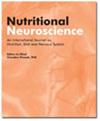Analysis of risk factors and development of predictive model for malnutrition in patients with traumatic brain injury.
IF 3.6
4区 医学
Q2 NEUROSCIENCES
引用次数: 0
Abstract
Malnutrition is a highly prevalent complication in patients with traumatic brain injury (TBI), and it is closely related to the prognosis of patients. Accurate identification of patients at high risk of malnutrition is essential. Therefore, we analyzed the risk factors of malnutrition in patients with TBI and developed a model to predict the risk of malnutrition. A retrospective collection of 345 patients with TBI, and they were divided into malnutrition and comparison groups according to the occurrence of malnutrition. Univariate correlation and multifactor logistic regression analyses were performed to determine patients' malnutrition risk factors. We used univariate and logistic regression (forward stepwise method) analyses to identify significant predictors associated with malnutrition in patients with TBI and developed a predictive model for malnutrition prediction. The model's discrimination, calibration, and clinical utility were evaluated using the receiver operating characteristic (ROC) curve, calibration plots, and decision curve analysis (DCA). A total of 216 patients (62.6%) developed malnutrition. Multifactorial logistic regression analysis showed that pulmonary infection, urinary tract infection, dysphagia, application of NGT, GCS score ≤ 8, and low ADL score were independent risk factors for malnutrition in patients with TBI (P < 0.05). The area under the curve of the model was 0.947. Calibration plots showed good discrimination of model calibration. DCA showed that the column line plot models were all clinically meaningful when nutritional interventions were performed over a considerable range of threshold probabilities (0-0.98). Malnutrition is widespread in patients with TBI, and the nomogram is a good predictor of whether patients develop malnutrition.分析脑外伤患者营养不良的风险因素并建立预测模型。
营养不良是创伤性脑损伤(TBI)患者的一种高发并发症,与患者的预后密切相关。准确识别营养不良高危患者至关重要。因此,我们分析了创伤性脑损伤患者营养不良的风险因素,并建立了一个预测营养不良风险的模型。回顾性收集了 345 例创伤性脑损伤患者,根据营养不良发生情况将其分为营养不良组和对比组。通过单变量相关分析和多因素逻辑回归分析来确定患者的营养不良风险因素。我们使用单变量和逻辑回归(正向逐步法)分析确定了与创伤性脑损伤患者营养不良相关的重要预测因素,并建立了营养不良预测模型。利用接收者操作特征曲线(ROC)、校准图和决策曲线分析(DCA)对模型的区分度、校准和临床实用性进行了评估。共有 216 名患者(62.6%)出现营养不良。多因素逻辑回归分析显示,肺部感染、尿路感染、吞咽困难、使用 NGT、GCS 评分≤ 8 分和 ADL 评分低是创伤性脑损伤患者营养不良的独立风险因素(P < 0.05)。模型的曲线下面积为 0.947。校准图显示了模型校准的良好区分度。DCA显示,在相当大的阈值概率范围内(0-0.98)进行营养干预时,柱状线图模型都具有临床意义。营养不良在创伤性脑损伤患者中很普遍,而提名图能很好地预测患者是否会出现营养不良。
本文章由计算机程序翻译,如有差异,请以英文原文为准。
求助全文
约1分钟内获得全文
求助全文
来源期刊

Nutritional Neuroscience
医学-神经科学
CiteScore
8.50
自引率
2.80%
发文量
236
审稿时长
>12 weeks
期刊介绍:
Nutritional Neuroscience is an international, interdisciplinary broad-based, online journal for reporting both basic and clinical research in the field of nutrition that relates to the central and peripheral nervous system. Studies may include the role of different components of normal diet (protein, carbohydrate, fat, moderate use of alcohol, etc.), dietary supplements (minerals, vitamins, hormones, herbs, etc.), and food additives (artificial flavours, colours, sweeteners, etc.) on neurochemistry, neurobiology, and behavioural biology of all vertebrate and invertebrate organisms. Ideally this journal will serve as a forum for neuroscientists, nutritionists, neurologists, psychiatrists, and those interested in preventive medicine.
 求助内容:
求助内容: 应助结果提醒方式:
应助结果提醒方式:


